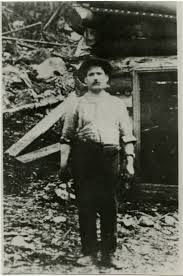
Miner
Alfred LaRose
1870 — 1940
Alfred LaRose, was a blacksmith working as a contractor on the railway being pushed through northern Ontario near Mile 103. About two weeks after Alfred McKinley and Ernest Darragh had made their discovery, LaRose noticed erythrite (red cobalt/cobalt bloom) along the tracks. LaRose noted "One evening I found a float, a piece as big as my hand, with little sharp points all over it. I say nothing but come back and the next night I take pick and look for the vein. The second evening I found it." He and his boss, Duncan McMartin staked claims on 3 Sept. 1903. The sample was sent to Toronto where it was classified as rich in nickel. Willet G. Miller, Ontario's first full time geologist followed up on the nickel indication with a visit to the district. Miller found that LaRose had exposed four veins. Three of the veins contained massive native silver including, as he reported, chunks as large as stove lids or cannon balls. The pink colour and mistakenly-identified nickel showing was cobalt bloom. This became the second mine in the Cobalt Silver Rush.
Last Updated on: 2024-02-28
